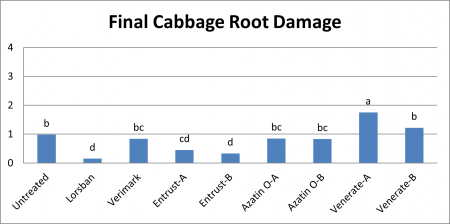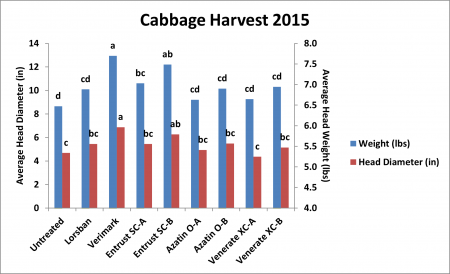The UMass Extension Vegetable Program conducted field trials evaluating insecticides to control cabbage root maggot (CRM) in 2014 and 2015. The goal of this research is to get new tools and materials into the hands of growers who have been struggling to control this pest with inadequate options and limited success. Our studies included evaluations of OMRI-approved insecticides and application methods for using Verimark (cyantraniliprole) as a tray drench and in direct-seeded brassica crops. We saw that Verimark provided excellent protection from CRM damage, and provided long-term protection from flea beetle and imported cabbageworm, when seedlings were treated in trays in the greenhouse. We were also excited to see that Entrust was able to protect plants from CRM damage and performed as well as the industry standard, Lorsban. When we started this work, Entrust was not labeled to control CRM outside of California, but in 2018 the soluble formulation Entrust SC and Radiant SC were both labeled to include soil drench treatments in the field (not tray drenches). Below is a summary of some of our work.
2015 Cabbage Drench Study
Materials and Methods
This year we looked at Verimark again as a tray drench. For the OMRI-approved materials, we tested each one as a tray drench alone, and also as a tray drench followed by one field application, made by drenching the soil at the base of the plant with a narrow band 10 days after the first treatment. Tray drench treatments were made by calculating the rate/plant needed to achieve the correct rate/acre and multiplying that by 128 for all the cells in the seedling tray. We then mixed that amount of product with 1.5 liters of water and put the mixture in a flat bottom 1020 impermeable tray and allowed the plants to soak up the material overnight. This year we had much better luck using this ‘bottom-watering’ technique because we used less water than last year (1.5 liters seemed to work well), and because it was sunny, so we were able to let the soil dry out a little and the plants soaked up the material quickly.
| table 1. products tested in 2015 cabbage drench study | |||
|---|---|---|---|
| product | Active ingredient | rate | Application Method |
| Untreated control | n/a | n/a | |
| Lorsban | chlorpyrifos | 2.75 fl oz/A | Banded over row after transplant |
| Verimark | cyantraniliprole | 13 fl oz/A | Tray drench |
| Entrust SC | spinosad | 10 fl oz/A | Tray drench |
| Entrust SC | spinosad | 10 fl oz/A | Tray drench plus banded at first flight |
| Azadirect | azadiractin | 2 pints/A | Tray drench |
| Azadirect | azadiractin | 2 pints/A | Tray drench plus banded at first flight |
| Venerate XC | Burkholderia spp. strain A396 | 1% solution | Tray drench |
| Venerate XC | Bukholderia spp. strain A396 | 1% solution | Tray drench plus banded at first flight |
The experiment was conducted at the University of Massachusetts Research and Education Farm in Deerfield, MA in a field with soil classified as Hadley silt loam. Soil was amended with 50 lb urea and 20 tons/A of manure-based compost to increase attractiveness of the site to CRM flies for egg laying. A randomized complete block design with 4 replications of each treatment and untreated control was used.
Each replicate plot consisted of 60 plants (two rows 18” apart and in-row spacing of 12” between plants) so that we could destructively sample plants over time to rate them for damage and still have enough plants left over to harvest in order to calculate yield. Once a week, plots were rated for overall plant vigor (0-100% based on size, color, stunting or discoloration caused by CRM, and leaf damage caused by flea beetle) and 10 plants per plot were randomly sampled and assessed for individual plant vigor and damage to roots caused by CRM.
Root damage was rated on the following categorical scale: 1= strong root development and no damage to main or secondary roots; 2=slight damage but secondary roots still present; 3=moderate root damage, i.e., not many secondary roots and secondary roots discolored; 4=severe damage, i.e., almost no roots present; and 5=plant completely dead. On 13 Jul, 10 cabbage plants per plot were harvested and head diameter and marketable yield was measured.
Results
Verimark again performed the best in terms of plant vigor and head size. This material is very effective against several major brassica pests and has a long residual–these plants sustained no FB or ICW damage until harvest. Lorsban had the least amount of root damage, but statistically, both Entrust treatments performed equally well. Both the drench alone and the drench plus in-field application of Entrust performed equally well, indicating that only the drench treatment is necessary, if it is well-timed with CRM egg-laying. If you put your transplants out much earlier than the beginning of May, you might need a follow-up in-field application, or it might make sense to skip the drench and just do the in-field soil drench. The goal is to have the material in the soil around the plant base at the time when flies are laying eggs and larvae are beginning to feed on roots. The two other OMRI-approved insecticides we evaluated did not perform well in terms of root damage, vigor, or yield–phooey.
Conclusions
Vermiark is a very effective new insecticide for use on conventional farms to control CRM. Entrust shows a lot of promise as a new tool for organic brassica growers, and as a rotational tool for others. The product is not currently labeled for use on CRM or for use as a drench treatment in the greenhouse or in the field–the label is the law and must be followed!



2015 Direct-Seeded Turnips Study
Materials and Methods
After seeing results from last year’s cabbage study, where Verimark performed really well, a lot of growers were excited to use this material in transplanted crops but also for directseeded crops like turnips and radishes which can be easily rendered unmarketable by CRM feeding damage. This year we experimented with applying Verimark to direct-seeded Hakeuri turnips as an infurrow drench at the time of seeding (Verimark-A) versus a banded application once the plants reached the 2 true-leaf stage (Verimark-B) compared to an untreated and a Lorsban-treated control.
The experiment was conducted at the University of Massachusetts Research and Education Farm in Deerfield, MA in a field with soil classified as Hadley silt loam. Soil was amended with 50 lb urea and 20 tons/A of manure-based compost to increase attractiveness of the site to CRM flies for egg laying. A randomized complete block design with 4 replications of each treatment and the untreated control was used. Hakeuri turnips were seeded with a Jang seeder on 05 May at 0.5” in-row spacing, with 3 rows per bed set 12” apart. The untreated control, Lorsban, and Verimark-A in-furrow drenches were applied at seeding using using a CO2 pressurized backpack sprayer equipped with a teejet 8002E nozzle and operating at 10psi to soak the soil in a narrow band. The Verimark-B treatments were applied on 14 May (9 days after seeding), once the crop had 2 to 4 true leaves by banding the material over the crop in a narrow band. We rated the plots weekly by counting the total number of plants in each plot and the number of plants with signs of damage (wilting and/or collapse). We also harvested 10 plants per plot to determine the incidence of root damage and marketable yield.
Results
Unfortunately, neither of the Verimark treatments performed as well as Lorsban in either plant stand or marketable yield. The two Verimark treatments (in-furrow at seeding versus banded application at the 2-leaf stage) performed statistically the same. They did not improve plant stand relative to the untreated control, but did significantly improve marketable yield.